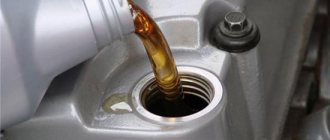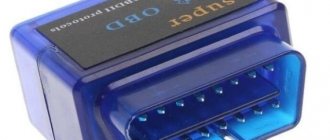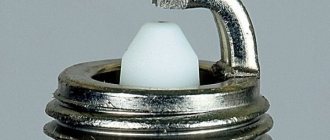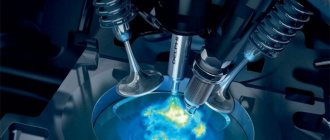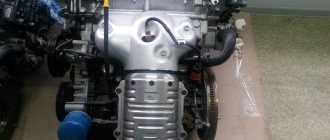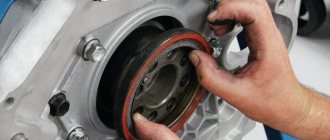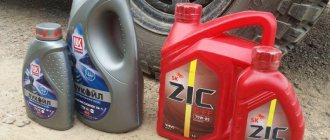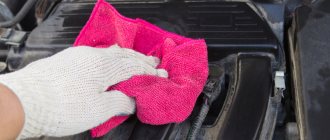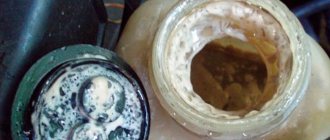Motor oil performs very important functions in the lubrication system of a car engine. Its main task is to create a film with a low coefficient of friction on the surfaces of contacting parts, reducing their wear. The lubricant effectively participates in the cooling process of the piston group and gas distribution mechanism. Oil also transports carbon deposits, metal microparticles formed during friction of metal surfaces, to the car’s filter system.
Maslozhor. The main reason. Repair
After a trip to relatives of 2000 km in both directions, the engine consumed 3 liters of oil.
This is despite the fact that I was still driving in the middle speed range. Well, finally you can start repairing. Everything needed was purchased in advance. To the previous story with pistons. I went to the market with scales and matched one piston by weight to the others. All pistons came out 242 gr., pins 68 gr. I took it apart, reassembled it, everything was as usual, nothing special. I will only describe some interesting points. The repairs carried out in May turned out to be completely useless. Then I changed the valve stem seals, but the oil consumption did not decrease at all. And within 2 months all the exhaust valves were again covered in the same soot. I had to disassemble the head again, clean the valves, grind them in, change the caps. Piston put more on the group. They entered more closely. Of course, I did everything like a complete amateur, without any measurements. everything is by eye. Unfortunately, there was no way to do this. I had to do the repairs in the village, I simply didn’t have enough time to remove and grind the block and take it somewhere. The wear on the cylinders is also uniform. Checking for ellipse (again by eye), it seems to be normal. I inserted a new ring, but the 0.05 mm feeler gauge didn’t fit anywhere)) The gap on the new rings was about 0.3 mm (almost nominal) on the old ones it was more than 0.5 mm, I didn’t measure it exactly. Enough for my lifetime. But what upset me most is that the new pistons have more valve counterbores than the old ones... This is probably exactly the change that was made in 2013 with the Prioro engine, so that lovers of 92 gasoline would whine less about the Priora shit, detonates and falls apart. I got confused and measured everything, spilled liquid: The volume of the counterbores of the old piston is about 0.4 cm3. The volume of the counterbores of the new piston is about 0.8-1.0 cm3.
We calculate the compression ratio (CL): Combustion chamber volume 126 cylinder head - 35 cm3 Thickness of gasket 21126 - 0.4 mm Piston shortfall - 197.1 (block height) - 37.8 (piston stroke / 2) - 133.3 (connecting rod length) - 25.4 (piston height) = 0.6 mm Total coolant on the new piston is 10.72 On the old piston the coolant was 10.82 For me, dynamics are above all, so this 0.1 is very important... but alas.
And now for lovers of plug-in pistons ala STK and so on. The volume of the countersinks, taking into account any displacers there, is 1.9 cm3. Information from the STI website, where they have forged pistons similar in shape. Although the displacer there, it seems to me, is even greater than on the STC. So, with this volume of coolant on plugless pistons it will be 10.47. You can even pour 92 benz)). And no matter what anyone says, they say there is no difference in dynamics, but you can’t argue with the numbers and you can’t fool physics. And since when did the ass meter become an official measuring device?))) Until the same engine is measured on a dyno, but with different pistons, to say that there is no difference is just self-hypnosis. Well, or yes, if you drive up to 3000 rpm, then even with a 124 engine there is no difference. But if you put two cars at a distance of 402 m with exactly the same engines and other equal conditions, but only one has standard pistons, and the other has no plugs, then the standard one will win, even if the body is, but it will be the first. And for me this is very important.
But the enlarged lanterns also have one advantage - the valve stroke at TDC has increased. For the intake valve, previously, with a counterbore depth of approximately 1.5 mm + 1 mm (underflow and gasket) + 0.5 mm (in the cylinder head), a clearance at TDC was obtained
3mm. Then now the depth of the piston counterbore
2.8 mm and the clearance at TDC is almost 4.5 mm. This can be safely installed on almost any evil wall with any overlap.
Well, here are the heroes of the occasion, MEET! Please love and favor, dead oil scraper rings))
I left the old connecting rods. By eye, again, everything is even, adjacent to each other evenly. And I’m more than sure there was no bend. There was not even a trace that someone had climbed into the engine before me. But the connecting rods, unfortunately, turned out to be AT. Hence the spread in weight across the connecting rods is 4 grams. Two connecting rods are 716 g, and two are 712 g. I tried to grind it down, but there was nowhere to sharpen the prior connecting rod, so I left it as is. Moreover, the car drove just fine before, and not bad at all. I tightened it as follows: Connecting rods in 2 sets 1. 20 Nm 2. turned to 135 degrees. I measured the cylinder head bolts, all less than 95mm long. I tightened it in 3 steps: 1. 20 Nm 2. tightened it by 90 degrees. 3. turned it up another 90 degrees.
I assembled it and run it in slowly. I drove more than 300 km, at least there is no plume of smoke like from old Lada cars like before))) and the level on the dipstick has not changed. We need to roll it out a little more and test it in combat mode. If everything goes well, that is, the consumption does not exceed reasonable values, then I’ll switch to good oil and I’ll need to roll out the firmware as normal, otherwise I couldn’t do this due to oil consumption. In total, I spent about 5 thousand rubles on repairs. Pistons 1000 rubles. Rings 1900 rub. Other, liners, gaskets, etc. 1000 rub. The mileage on the speedometer is 175 thousand km, but in fact it can be much more. These are the prioromotors)
Lada Priora consumes a lot of engine oil
Many motorists driving a Lada Priora encounter some problems after using it for a long time. Priora consumes oil - this malfunction occurs more often than others.
High oil consumption should alert the driver and serve as a reason to send his own car for diagnostics to a specialized service center.
- Purpose of motor oil
- Why is lubricant quickly used up?
- Oil waste
- Violation of the tightness of sealing joints in the form of oil seals or gaskets
- Damage to power plant mechanisms
- Oil leak through breather
- Oil getting into the cooling system
- Conclusion
Purpose of motor oil
The operating manual of any machine contains information about oil consumption. Lubricating fluid allows all car components to operate fully and efficiently. When driving, many interconnected processes take place in the engine.
Friction appears between contacting parts, which has a destructive effect on motor parts. Motor oil reduces the negative effects of friction and wear of spare parts.
With increased Priora oil consumption, the contacting parts are not able to properly perform their task. They are subject to abrasion, the engine jams and breaks. In order for the machine to operate continuously and for a long time, it is necessary to control the volume of oil fluid.
Why is lubricant quickly used up?
"Priora", despite its modern engine, "eats" a lot of oil. The reasons for this are as follows:
- the appearance of a leak;
- wear of spare parts;
- low quality motor oil;
- exceeded operating period;
- burning of oil liquid.
Often, car oil leaks occur due to poor crankcase ventilation. This happens because the exhaust enters the crankcase through the piston rings. Gases create increased compression, which disrupts the normal flow of processes in the unit. The oil is simply squeezed out of the engine.
Why do Priors eat oil, besides the reasons listed above? Oil is probably leaking from the valve plug or oil filter. To eliminate such leaks, the lining must be replaced. Constant vibration exposure, high loads, trips over rough terrain - all this causes various leaks.
Synthetics have good viscosity characteristics, ensuring the uninterrupted functioning of all units. It contains many additives that soften and partially eliminate the consequences of the negative impact on the power unit.
Mineral water does not have the advantages of synthetics. It pollutes the lubricating complex with its own combustion products. As a result, it turns out that the car “eats” oil.
An excessive operating period may also be the reason that the machine eats oil. Since the characteristics of the motor oil deteriorate during operation, some of the lubricant evaporates and burns out.
This negatively affects the car engine. Timely measures taken will allow the power unit to operate without failures for a long time.
Where does it go?
The correct operation of internal combustion engines largely depends on whether there is a sufficient amount of lubricants inside. Oil, as noted above, is necessary to reduce friction between the rubbing surfaces of parts. The most intense friction is in the parts of the cylinder-piston group. Since high temperatures are constantly maintained in the engine, some of the oil burns out in the cylinders and is then removed along with the exhaust gases. Also, part of the lubricating fluid settles on the cylinder walls, on valve seats, and on oil scraper piston rings.
Increased consumption, complaints from drivers that the Priora is consuming oil - this is a sign that the engine has one or more malfunctions. Most often, the reason is very banal - it is natural wear and tear of the CPG. The first call is oil in the crankcase ventilation system. This happens due to high gas pressure in the crankcase. This pressure will increase as the engine wears out.
Oil waste
The car can “eat” consumables due to burnout. This is due to the fact that the oil indicators do not correspond to the characteristics of a particular engine. An excessively liquid oil product will remain in the cylinder block and burn out. And if it is too thick, it will envelop the moving parts with a dense film, significantly complicating their movement.
All this will lead to increased oil costs. In view of this, you need to use only the lubricant recommended by the car manufacturer.
Severe burnout can occur due to worn valve seals. Identifying this problem is quite difficult. To prevent the lubricant from smoking, that is, to stop burning, the seals need to be replaced. The piston rings also need to be changed. If they wear out significantly, engine repair may be required.
What is increased consumption
By the term “eating oil”, car owners mean increased consumption of lubricating motor fluids.
Often, during normal operation, such waste should not occur - the standards established by the manufacturer will be observed if there are no problems. If the technical documentation for the car states that replacement should be carried out once every 10 thousand kilometers, and the driver has to top it up more often, then this is an increased consumption.
Violation of the tightness of sealing joints in the form of oil seals or gaskets
The appearance of oil from under the valve covers or cylinder head gasket. Where oil leaks, it mixes with dust and forms a characteristic coating. There can be several reasons for a leak:
- Failure of the gasket itself, since the product is rubber. The repair is not difficult, but requires care when tightening the bolts.
- The appearance of oil under the gaskets is caused by an increase in pressure in the engine lubrication system. There may be four reasons here:
- The first and most important is the failure of the oil pump pressure reducing valve, which maintains the pressure within certain limits. It can only be repaired by replacing this device.
- Second, use very viscous oil. Do not skimp on oil; fill in the oil specified in the service book by the car manufacturer.
- Third, clogged oil channels (for worn engines). Occurs when using various flushing liquids of dubious purpose (meaning “decarbonization”).
- Fourth, a violation of crankcase ventilation, in which gases accumulate under the valve cover and oil pressure begins to increase, oil appears in the air filter. Cause: The separator screen is clogged and needs to be cleaned.
- The appearance of oil leakage from under the seals. There are three reasons for this malfunction:
- First, the oil seal simply wore out over time.
- Second, the pressure in the car’s lubrication system is increased.
- The third option is the hardest. The rotating parts of the power unit wear out in the form of bearings, rings, half rings, etc. In this case, the alignment of the units is disrupted and the parts become distorted. There is no need to replace the oil seals in case of this malfunction; this will only give a temporary effect. The intervention of an engine repair specialist will be required.
Conclusion
The choice of oil for the car must correspond to that recommended in the operating instructions. Replace filters in a timely manner and monitor the condition of the coolant.
Be sure to warm up a cold engine, especially in winter. Do not use flushing fluids from unknown manufacturers. With this approach, the heart of your car will work for a long time and without loss of oil.
Died
I love cars in all forms. I've been tinkering under the hood since childhood. I know all the ins and outs of Russian cars and some imported ones. I will be happy to share my knowledge with everyone who likes to do everything with their own hands.
Damage to power plant mechanisms
Damage to the power plant mechanisms responsible for proper mixture formation and oil separation in the combustion chamber (piston scuffing, oil scraper rings sticking, valve burnout, disappearance of honing, etc.)
In this case, the oil enters the combustion chamber of the car, where it mixes with fuel and air vapors and burns completely. Oil consumption with such a malfunction can be enormous, more than 1 liter per 1 km. Black smoke begins to pour out of the exhaust pipe. This malfunction is caused by driving on a “cold” engine.
After 50-60 cold starts, honing sets the oil scraper rings in one direction, the seal is broken and oil consumption increases. The skirt comes off the pistons, the valves burn out, the oil seals become hard. There is only one treatment - engine overhaul.
Troubleshooting Methods
The first thing to do is to find possible leaks by carefully inspecting the valve cover. If there are leaks on the engine oil pan, drain the oil, then unscrew the pan and change its gasket, preferably placing it on sealant. If there is a leak through the crankshaft seals, replacing them yourself will be very problematic. It is better to carry out repairs at a service station.
Another reason for increased consumption may be a clogged crankcase ventilation system. Over time, resin deposits and carbon products are deposited on the walls of the pipe, which makes it difficult to remove gases that have escaped from the combustion chamber. This creates excess pressure in the crankcase, which forces oil through the seals and seals. Oil mist will enter the combustion chamber in excess through the ventilation system and intake manifold, which will lead to a decrease in the calorific value of the fuel and loss of engine power. To prevent this problem, it is necessary to regularly clean the ventilation system pipes: approximately every 50 thousand kilometers.
You should be careful about the quality of the lubricants used. They must comply with those recommended by the manufacturer, taking into account the climatic zone of the vehicle's operation. By following all the necessary recommendations, eliminating the indicated malfunctions and abandoning an aggressive driving style, you can significantly reduce the consumption of fuel and lubricants in your car.
Oil leak through breather
Oil loss through the breather is a very unpleasant problem. A breather is a device that compares the crankcase pressure of a power plant with atmospheric pressure. Without it, air would not get into the engine at all. Reasons for this malfunction:
- Air filter condition. The engine simply doesn't have enough air.
- Filling the lubrication system above a certain level. The excess is simply squeezed out through the breather.
- Worn oil scraper rings. As a result, excess pressure appears in the engine crankcase, which expels oil through the breather.
If the first two faults are easy to deal with, then the third one will have to go to a service station. Very rarely, the oil deflector rod may become clogged. In this case, gasoline and oil vapors do not pass into the oil separator, but are deposited in the breather, and a characteristic smell of gasoline is present.
Natural wear and tear
If the Priora engine consumes oil, then most likely the engine has a high mileage, and the reason for oil consumption is the natural wear and tear of the engine itself and its individual components. As a result, oil will be consumed much faster than during normal operation. Engine wear can also be the cause of cylinder deformation, cracks, gasket burnout, and failure of engine seals. Motor oils can be deposited in engine parts and components, but it can be difficult to determine how large the excess consumption is. It depends on how worn out the engine and other systems in the car are.
Why does Lada Priora “eat” oil?
Motor oil and its main functions
Main reasons for increased oil consumption
Despite the fact that the Lada Priora has an improved engine, it consumes a certain amount of engine oil. Oil consumption increases significantly if:
- there is a leak,
- parts are worn out,
- low-quality oil is used,
- oil service life has been exceeded,
- oil combustion,
- oil evaporation
The cause of oil leakage is poor crankcase ventilation. This happens when exhaust gases enter the crankcase through the joints of the piston rings. Excessive gas pressure occurs in the crankcase, which leads to the destruction of all processes in the lubrication system. The crankcase ventilation system is designed to remove these gases. After the gases are removed, the pressure returns to normal. But if the ventilation system channels are dirty, excess pressure will force the oil through the rubber seals. Therefore, it is so important to normalize the operation of the crankcase ventilation system.
The reason for wear of parts is operating the car in one mode: operating the car at high speeds for a long time. Therefore, it is recommended to switch to a lower engine speed mode, otherwise engine repair is inevitable.
Using low-quality oil. For any car, and Lada Priora is no exception, it is recommended to use the oil offered by the plant that produced the car. If you initially use synthetic oils, then it is possible to switch to another oil - semi-synthetic. Cheap mineral analogues are best used on low-speed engines, but not in Lada Priora.
The service life of the oil must not be exceeded, because This will cause the oil level to drop. During oil operation, the oil interacts with gases, fuel and rubbing parts, as a result of which it loses its properties.
Engine oil waste is the most common cause of losses.
A drop in oil level is a consequence of its evaporation process. This is caused by a change in the lubricating properties of the engine oil. Due to the fact that different brands of oils have different viscosities, they are recommended to be used under certain temperature conditions, which is also recommended by the manufacturer.
The problem of increased oil consumption can be partially solved by switching from synthetics to semi-synthetics. Semi-synthetics contain an additional number of additives and compensators, making them more practical and reliable.
Oil may burn due to worn valve caps. This problem can be diagnosed visually: blue smoke when the engine starts. In this case, the caps must be replaced. If this is not done in a timely manner, engine repair will be necessary. With a more thorough diagnosis of all Lada Priora systems, it is possible to identify the problem of why the car “eats” oil. The result could be any of the reasons discussed above. Therefore, timely elimination of the malfunction entails an extension of the engine service life. 08/02/2019
The manufacturer writes in the operating manual that the consumption of a certain amount of engine oil during normal engine operation is normal. This amount depends mainly on the quality and viscosity of the oil, as well as on the operating conditions of the vehicle. We decided to determine how many Lada car owners use oil and in what quantity...
AvtoVAZ installs the following engines on Priora, Grant and Kalina:
- VAZ-21116 (8cl, 1.6l, 87hp). Oil consumption rate: 50 g/1000 km.
- VAZ-21126 (16kl, 1.6l, 98hp). Oil consumption rate: 50 g/1000 km.
- VAZ-21127 (16cl, 1.6l, 106hp). Oil consumption rate: 50 g/1000 km.
- VAZ-21128 (16cl, 1.8l, 98hp). Oil consumption rate: 300 g/1000 km.
For the first three engines, oil consumption should not exceed 50g/1000km. The latest engine (VAZ-21128) is a modified version of the VAZ-21127 engine. The peculiarity of the 1.8 liter engine is that, while the block height remains unchanged, the piston stroke was increased (with a long-stroke crankshaft). This was achieved through the use of short connecting rods. This decision caused a high load on the connecting rod, walls, piston and rings. As a result of increased wear, the oil consumption of this engine can be up to more than 3 liters per 1000 km.
Low quality oils
One of the reasons for increased consumption is the low quality of this same oil or the wrong choice. For each engine, including the Lada Priora, there are certain tolerances. But if you make the wrong choice, your consumption can skyrocket. For example, reduced viscosity can cause the rings to fail and collect lubricant from the cylinder walls. Therefore, the lubricant will settle on the walls of the combustion chamber and, as a result, will burn along with the fuel.
As a result, exhaust gases will come out in the form of bluish smoke, and the oil will settle as soot on the spark plugs. For the same reason, the rings become coked. Oil settles in a very thick layer on engine parts and components.
Engine oil consumption rates according to the manual
Lada Priora is equipped with four power units of different modifications and each of them has a certain oil consumption:
- VAZ-21116 (8cl, 1.6l, 87hp) – 50 g/1000 km
- VAZ-21126 (16cl, 1.6l, 98hp) – 50 g/1000 km
- VAZ-21127 (16cl, 1.6l, 106hp) – 50 g/1000 km
- VAZ-21128 (16cl, 1.8l, 98hp) – 300 g/1000 km
As you can see, for the first three power units the consumption rate does not exceed 50 g per 1000 kilometers, and the last engine, which is a modernized version of the engine from the VAZ 21127, consumes much more.
The key feature of the 1.8-liter engine is that, while the block height remained unchanged, the piston stroke was increased due to a different crankshaft. This was realized using short connecting rods. This design solution led to increased load on the following engine elements:
In some cases, if there is excessive wear of parts of the Priora power unit, there is oil in a volume of up to 2-3 liters per 1000 kilometers.
Reasons for high engine oil consumption
- Unsuitable engine lubricant.
- Malfunction of the power unit (wear of valve stem seals, piston rings and other components).
- Aggressive driving style (high speeds, frequent and sudden acceleration, etc.).
- The rings, pistons and cylinder walls of the engine have not had time to break in after a major overhaul or the engine is still new.
Oil leakage
In some cases, the Priora eats oil, but does not smoke. The problem may not be the oil consumption, but the fact that it is leaking somewhere. Lubricant may leak from the engine in places such as:
- Valve cover gasket located on the top of the engine. If the seal is broken, oil smudges become clearly visible on the outer walls of the engine on the sides. As a rule, a lot of oil will not escape through the gasket, but it is better to restore the seal.
- Cylinder head gasket. It is also located in the upper part of the engine under the cylinder head. The gasket can be damaged in different places, causing oil leakage (symptoms are similar to those mentioned above). Also in this case, sometimes the oil goes into the cooling system if that part of the gasket that is located between the system holes and the working cylinders of the engine is broken. Externally, the engine will be dry, but the coolant will become cloudy, and the oil in the engine will begin to foam (this can be seen on the inside of the neck cap).
- Camshaft and crankshaft oil seals. Not on all engines this leak is noticeable under the hood, since all leaks form under the engine. In advanced cases, oil stains may remain on the crankcase guard or on the ground.
- Crankcase gasket. You can notice such a leak by lifting the car on a lift or driving it onto an overpass and removing the engine protection.
- Rear crankshaft oil seal. It is usually changed when the transmission is removed, otherwise you won't be able to get to it. Leaks can be detected by smudges at the bottom of the engine on the gearbox side.
- Gasket under the oil filter. This is rare, but this possibility cannot be excluded.
Engine oil waste
If the Priora is consuming oil, the reasons may be different, and diagnosing them when the lubricant burns is not difficult. When the oil burns out, blue smoke comes out of the exhaust pipe, which does not happen when running on high-quality gasoline (black smoke is a sign of improper operation of the injection system). Also, if the engine burns too much oil over time, it will create an oily black edge on the edges of the exhaust pipe.
It is not easy to determine the real cause of engine oil burnout, and without opening the engine it is almost impossible to do this. At the same time, there are certain ways to combat oil burner that you can try before opening the engine.
First, you should get used to the idea that oil is burned in any engine. It cannot fail to burn in it at all, since it forms an oil film on the surfaces of the cylinders in which the fuel mixture is burned. What is important is how much oil is burned in the power unit, and what the burn rate is for a specific engine model.
Priora's oil consumption depends, as we have already said, on the operation of the engine. The higher the engine speed, the more oil will be burned.
Piston rings
Another reason why a car eats special fluid is the piston rings. Each piston has three rings - an oil scraper ring on the bottom and two compression rings on top. The automaker uses compression rings to reduce the distance between the cylinder wall and the piston itself, thereby achieving maximum energy transfer to the engine. To reduce the friction created, lubricating fluid is supplied to the compression rings, which is then removed by oil scraper rings. The wear of these rings is the reason why the Priora eats the special fluid - they simply leave excess lubricant on the cylinder walls. So the reason for increased waste of lubricant may be piston rings, but not always engine malfunction.
Over the course of its entire “life,” Priora is subjected to a huge number of heating-cooling cycles. Accordingly, a high load falls on all components and parts of the motor. A decrease in the elasticity of the piston rings or their wear can cause a phenomenon such as flutter. This phenomenon has been poorly studied, but it is known that during engine operation, the rings move around the piston radius with a certain frequency, but at the same time they can jump from one edge of the piston groove to the other. Such sharp jumps are the reason that the Priora eats large quantities of lubricant, but does not smoke, although a clear sign of such a malfunction is the bluish-colored exhaust smoke.
Why does Lada Priora “eat” oil?
Motor oil and its main functions
Main reasons for increased oil consumption
Despite the fact that the Lada Priora has an improved engine, it consumes a certain amount of engine oil. Oil consumption increases significantly if:
- there is a leak,
- parts are worn out,
- low-quality oil is used,
- oil service life has been exceeded,
- oil combustion,
- oil evaporation
The cause of oil leakage is poor crankcase ventilation. This happens when exhaust gases enter the crankcase through the joints of the piston rings. Excessive gas pressure occurs in the crankcase, which leads to the destruction of all processes in the lubrication system. The crankcase ventilation system is designed to remove these gases. After the gases are removed, the pressure returns to normal. But if the ventilation system channels are dirty, excess pressure will force the oil through the rubber seals. Therefore, it is so important to normalize the operation of the crankcase ventilation system.
The reason for wear of parts is operating the car in one mode: operating the car at high speeds for a long time. Therefore, it is recommended to switch to a lower engine speed mode, otherwise engine repair is inevitable.
Using low-quality oil. For any car, and Lada Priora is no exception, it is recommended to use the oil offered by the plant that produced the car. If you initially use synthetic oils, then it is possible to switch to another oil - semi-synthetic. Cheap mineral analogues are best used on low-speed engines, but not in Lada Priora.
The service life of the oil must not be exceeded, because This will cause the oil level to drop. During oil operation, the oil interacts with gases, fuel and rubbing parts, as a result of which it loses its properties.
Engine oil waste is the most common cause of losses.
A drop in oil level is a consequence of its evaporation process. This is caused by a change in the lubricating properties of the engine oil. Due to the fact that different brands of oils have different viscosities, they are recommended to be used under certain temperature conditions, which is also recommended by the manufacturer.
The problem of increased oil consumption can be partially solved by switching from synthetics to semi-synthetics. Semi-synthetics contain an additional number of additives and compensators, making them more practical and reliable.
Oil may burn due to worn valve caps. This problem can be diagnosed visually: blue smoke when the engine starts. In this case, the caps must be replaced. If this is not done in a timely manner, engine repair will be necessary. With a more thorough diagnosis of all Lada Priora systems, it is possible to identify the problem of why the car “eats” oil. The result could be any of the reasons discussed above. Therefore, timely elimination of the malfunction entails an extension of the engine service life. 08/03/2019
The manufacturer writes in the operating manual that the consumption of a certain amount of engine oil during normal engine operation is normal. This amount depends mainly on the quality and viscosity of the oil, as well as on the operating conditions of the vehicle. We decided to determine how many Lada car owners use oil and in what quantity...
AvtoVAZ installs the following engines on Priora, Grant and Kalina:
- VAZ-21116 (8cl, 1.6l, 87hp). Oil consumption rate: 50 g/1000 km.
- VAZ-21126 (16kl, 1.6l, 98hp). Oil consumption rate: 50 g/1000 km.
- VAZ-21127 (16cl, 1.6l, 106hp). Oil consumption rate: 50 g/1000 km.
- VAZ-21128 (16cl, 1.8l, 98hp). Oil consumption rate: 300 g/1000 km.
For the first three engines, oil consumption should not exceed 50g/1000km. The latest engine (VAZ-21128) is a modified version of the VAZ-21127 engine. The peculiarity of the 1.8 liter engine is that, while the block height remains unchanged, the piston stroke was increased (with a long-stroke crankshaft). This was achieved through the use of short connecting rods. This decision caused a high load on the connecting rod, walls, piston and rings. As a result of increased wear, the oil consumption of this engine can be up to more than 3 liters per 1000 km.
Engine oil consumption rates are indicated in information letter No. 62-12 of 2012. The maximum permissible oil consumption for VAZ car engines, excluding lubricant changes, is no more than 0.7 liters per 1000 km
vehicle mileage.
Reasons why Kalina, Granta and Priora eat oil:
- Unsuitable engine oil.
- Engine malfunction (worn oil seals or piston rings, etc..).
- Increased oil consumption may be due to driving the vehicle at high speeds with frequent acceleration.
- The pistons, piston rings and cylinder walls of the engine are not worn in (the engine is new or after a major overhaul).
Let us remind you that the oil consumption on the new VAZ-21129 and 21179 engines is different. What is the oil consumption on your Lada car? Have you encountered oil burns and how did you solve the problem?
' w /> Oil zhor
, Priora 1.6 16 bugs
In general, I have a Priorka 2008 model year. According to the odometer - 110 thousand, in fact I don’t know. It eats a liter of oil per thousand km. It doesn’t leak anywhere, doesn’t snot, everything is dry. Doesn’t smoke much. As I understand it, either Moscow time, or rings? There is no carbon deposits on the threads of the spark plugs, and it’s unlikely that much will be lost because of the caps, most likely the rings are stuck. I plan to take it in for repairs one of these days. I want to install Avtramatov pistons, since I’m going to get into the engine. Will I get by with a little blood( i.e. replacing pistons with rings) or is a specific ellipse in the cylinders possible? I understand that an autopsy will show, but has anyone encountered such a problem? What kind of finances can I count on? Maybe someone can recommend an intelligent motor mechanic - because at most I I did and changed the cylinder head gasket on the 16-bed buggy model. And then there are groups of pistons, and suddenly for a repair group, etc. and so on.
Post edited by sergio150890
– Nov 4 2013, 22:43
Messages: 5 211 From: Cheboksary
I also ate butter because of the rings. also replacing the piston group. it came out to 7 thousand for the work + 10-11 for the salary.
Post edited by RAMMs
– Nov 4 2013, 22:51
Messages: 2 654 2110 1.6, 16 cl
Perhaps the valves got stuck at some point, in which case I would change the connecting rods at the same time.
Post edited by X
– Nov 4 2013, 22:58
